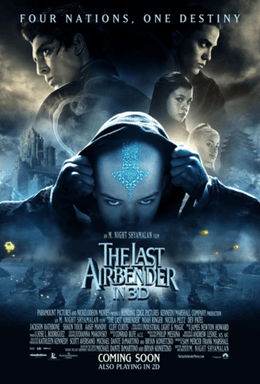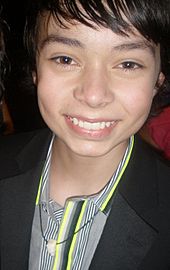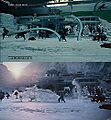The Last Airbender facts for kids
Quick facts for kids The Last Airbender |
|
|---|---|

Theatrical release poster
|
|
| Directed by | M. Night Shyamalan |
| Produced by |
|
| Written by | M. Night Shyamalan |
| Starring |
|
| Music by | James Newton Howard |
| Cinematography | Andrew Lesnie |
| Editing by | Conrad Buff |
| Studio |
|
| Distributed by | Paramount Pictures |
| Release date(s) | June 30, 2010 (New York City) July 1, 2010 (United States) |
| Running time | 103 minutes |
| Country | United States |
| Language | English |
| Budget | $150 million |
| Money made | $319.7 million |
The Last Airbender is an action-adventure fantasy movie from 2010. It was written, co-produced, and directed by M. Night Shyamalan. The film is based on the first season of the popular Nickelodeon animated TV show Avatar: The Last Airbender.
The movie stars Noah Ringer as Aang, Dev Patel as Prince Zuko, Nicola Peltz as Katara, and Jackson Rathbone as Sokka. The idea for the film started in 2007. It was made by Nickelodeon Movies and released by Paramount Pictures. The movie first showed in New York City on June 30, 2010. It then opened across the United States the next day.
When it came out, many critics, viewers, and fans of the original cartoon did not like the movie. Some people thought it was one of the worst movies ever made. They often criticized the story, acting, and how different it was from the TV show. The Last Airbender made about $319 million worldwide. It was planned to be the first of three movies, but the other two were canceled. This was because the first movie was not very popular and did not make enough money. Later, Netflix decided to make a new live-action show based on the cartoon instead.
Contents
Movie Story: A World of Elements
A long time ago, the Fire Nation started a war against the Air, Water, and Earth nations. They wanted to take over the whole world. One day, Sokka and his sister Katara, from the Southern Water Tribe, found a strange iceberg. When they broke into it, a bright light appeared. Inside, they found a 12-year-old boy named Aang and his flying bison pet, Appa.
Zuko, a prince from the Fire Nation, saw the light. He came to the Southern Water Tribe looking for "The Avatar." The Avatar is the only person who can control, or "bend," all four elements: air, water, earth, and fire. Aang gave himself up to save the village. But he soon escaped the Fire Nation ship with Katara and Sokka's help. They flew away on Appa.
The three friends traveled to the Southern Air Temple. There, Aang learned he had been frozen in the iceberg for a century. He also found out that the Fire Nation had destroyed all the Air Nomads, including his guardian, Monk Gyatso. Feeling very sad, Aang entered the Avatar State. This is a powerful mode where he connects to the Spirit World. Katara's words helped Aang return to his normal self.
Aang and his friends arrived at an Earth Kingdom village. The Fire Nation controlled this village. When they were put in prison, they started a rebellion. They fought and defeated the Fire Nation soldiers. Aang told Katara and Sokka that he only knew how to airbend. He still needed to learn water, earth, and firebending. They decided to go to the Northern Water Tribe. Aang could learn from waterbending masters there.
During a trip to the Northern Air Temple, Aang was captured by Fire Nation archers. They were led by Commander Zhao. However, a masked person called ‘The Blue Spirit’ helped Aang escape. Zhao soon realized that Zuko was the Blue Spirit. Zhao tried to kill Zuko, but Aang saved him. Aang then left to find Sokka and Katara. Zhao tried again to kill Zuko by blowing up his ship. But Zuko secretly survived and got onto Zhao's ship.
When they arrived, the people of the Northern Water Tribe welcomed Aang and his friends. Waterbending Master Pakku began teaching Aang and Katara. The Fire Nation attacked, and Zhao started his plan. Zuko kept looking for the Avatar on his own. After beating Katara in a fight, Zuko captured Aang. Aang went into the Avatar State again. He looked for the Dragon Spirit for help to defeat the Fire Nation. The Dragon Spirit told him to let his feelings "flow like water."
Aang returned to his body and fought Zuko. Katara froze Zuko in ice, then joined the main battle. Iroh and Zhao went to a special cave. Zhao captured the Moon Spirit there. Even though Iroh begged him not to, Zhao killed the Moon Spirit. This made all the waterbenders lose their powers. Iroh got very angry and showed his powerful firebending. This scared Zhao and his soldiers away. Princess Yue gave her own life to bring the Moon Spirit back. Zhao found out Zuko was alive, and they prepared to fight. But Iroh stopped Zuko, and waterbenders drowned Zhao. Remembering his life before the ice, Aang entered the Avatar State. He raised the ocean into a giant wall, pushing the Fire Nation back.
The Fire Lord learned about the defeat. He then told his daughter, Azula, to stop the Avatar from mastering earth and fire.
Meet the Characters

- Noah Ringer as Aang:
A young airbender who disappeared 100 years ago. He is 12 years old but has been frozen for a century. Aang is the latest Avatar, meaning he can bend all four elements. At first, he only knows airbending. - Dev Patel as Prince Zuko:
A 16-year-old prince from the Fire Nation. He travels with his Uncle Iroh. Zuko was sent away by his father, Fire Lord Ozai. He has a scar on his face from a fight with his father. Zuko must capture the Avatar to get his honor back. - Nicola Peltz as Katara:
A 14-year-old girl from the Southern Water Tribe. She is the last waterbender in her tribe. Katara takes on a motherly role in her family after her mother passed away. - Jackson Rathbone as Sokka:
Katara's 15-year-old brother and a warrior from the Southern Water Tribe. He cannot waterbend. Sokka often comes up with plans and leads the group. - Shaun Toub as General Iroh:
Zuko's uncle and Fire Lord Ozai's brother. He is kind and acts like a father to Zuko. Iroh was once a great general. He is the only firebender in the movie who can bend fire using only his inner energy. - Aasif Mandvi as Admiral Zhao:
A Fire Nation Commander who is very hot-tempered. He is Zuko's main enemy and wants to capture the Avatar. - Seychelle Gabriel as Princess Yue:
The princess of the Northern Water Tribe. She becomes Sokka's love interest. She bravely sacrificed herself to save her tribe and help balance the world. - Cliff Curtis as Fire Lord Ozai:
The powerful leader of the Fire Nation. He is Iroh's brother and the father of Prince Zuko and Princess Azula. - Summer Bishil as Princess Azula:
Fire Lord Ozai's 14-year-old daughter and Zuko's sister. She appears at the end of the movie, ready to hunt her brother, uncle, and the Avatar. - Francis Guinan as Master Pakku:
A waterbending master from the Northern Water Tribe. He teaches Aang how to waterbend. - John Noble as the voice of The Dragon Spirit:
A new character who helps Aang in the Spirit World.
Making the Movie
Choosing the Actors
Director M. Night Shyamalan chose Noah Ringer to play Aang. He picked Jackson Rathbone for Sokka, Nicola Peltz for Katara, and Dev Patel for Zuko. Shyamalan said he really wanted Nicola Peltz for Katara. He felt the same way when he cast Haley Joel Osment in The Sixth Sense.
Dev Patel took over the role of Zuko from Jesse McCartney. McCartney's music tour dates conflicted with the movie's martial arts training. Patel sent in an audition tape before his movie Slumdog Millionaire came out. He felt Zuko's strong desire for his father's approval was something many kids could understand. Patel said the movie was more serious than the cartoon.
Noah Ringer started practicing Taekwondo when he was 10. He shaved his head to stay cool during training. This made him look like Aang from the cartoon, earning him the nickname "Avatar." He sent an audition tape to the filmmakers. Since he had not acted before, Ringer went to acting school for a month before filming. Nicola Peltz was already a fan of the animated series before she tried out for Katara.
Filming Locations
Filming started in March 2009 in Greenland. After two weeks, the team moved to Reading, Pennsylvania. Here, they prepared a local site for the movie. The Pagoda on Mount Penn was used as an ancient temple in the film. Some scenes were also shot in Philadelphia.
Special Effects
The team at Industrial Light and Magic created the movie's visual effects. They had to make the "bending" styles for air, water, earth, and fire look real. They also animated creatures and made stunt work look even better with digital effects.
Making fire and water look real and bendable was very hard. Earthbending was also tricky because of how particles behave. For water, they used different methods for different sizes of water. The idea for airbending came from the TV show. To make it look real, they showed dust and snow particles moving, instead of just the air itself. The actors' movements had to match the bending effects. Each character had a unique bending style to fit their personality.
For fire, the challenge was making it look believable even though it was behaving in an unrealistic way. They looked at how flames move when pushed by giant fans. They decided to use computer-generated fire for a richer look.
The movie also used matte paintings to create backgrounds. These had to be in 3D because the camera was always moving. The big final battle scene combined the set with pictures of Greenland landscapes. Multiple cameras were used for fight scenes and to create creatures. For the flying lemur Momo, they studied real animals like giant fruit bats to make his wings look real.
In April 2010, Paramount Pictures announced that The Last Airbender would be released in 3D. The movie's visuals and slow camera movements helped with the 3D conversion.
Movie Music
James Newton Howard composed the music for The Last Airbender. This was his seventh time working with M. Night Shyamalan. The music for the movie's trailers was also created by Howard. The soundtrack was released on June 29, 2010. It featured a large orchestra with 119 musicians. The music received very positive reviews.
Promoting the Movie
Trailers and Toys
The first short preview for the movie was shown with Transformers: Revenge of the Fallen in June 2009. It showed Aang airbending in a temple. More trailers were released before the movie came out.
In February 2010, Nickelodeon Consumer Products showed off the new toys for The Last Airbender. These included action figures of Aang, Prince Zuko, Sokka, and Katara. There was even a large, rideable Appa the Sky Bison toy. A video game based on the movie was also released for the Wii and Nintendo DS.
Graphic Novels
Two black-and-white graphic novels were released. They were called The Last Airbender Prequel: Zuko's Story and The Last Airbender. They were drawn in the manga style. Zuko's Story was released in May 2010. It tells about Prince Zuko's journey after his father banished him. He searches for the Avatar to get his honor back. The second graphic novel, The Last Airbender, came out in June 2010. It was a shorter version of the first season of the TV show.
Movie Release
To avoid confusion with James Cameron's movie Avatar, the film's title was changed to The Last Airbender. The movie first showed in New York City on June 30, 2010. It opened in many theaters the next day.
Box Office Success
The Last Airbender earned over $319 million worldwide. On its first day in the United States, it made over $16 million. Over its first long weekend, it made more than $40 million. About half of its earnings came from 3D showings. The movie was the twentieth highest-grossing film of 2010.
Home Release
The Last Airbender was released on DVD and Blu-ray on November 16, 2010. A Blu-ray 3D version was also available. The movie was released again on DVD and Blu-ray in April 2017.
Awards and Nominations
The Last Airbender received several nominations at the 31st Golden Raspberry Awards. These awards recognize films that are considered the worst of the year. The movie won five awards, including Worst Picture, Worst Director for M. Night Shyamalan, and Worst Screenplay.
| Year | Award | Category | Nominee | Result | Ref. |
|---|---|---|---|---|---|
| 2010 | Teen Choice Awards | Choice Summer: Movie | The Last Airbender | Nominated | |
| International Film Music Critics Association | Film Music Composition of the Year for "Flow Like Water" | James Newton Howard | Nominated | ||
| Best Original Score for a Fantasy/Science Fiction/Horror film | Nominated | ||||
| Young Artist Award | Best Performance in a Feature Film (Leading Young Actor) | Noah Ringer | Nominated | ||
| Best Performance in a Feature Film (Supporting Young Actress) | Seychelle Gabriel | Nominated | |||
| 31st Golden Raspberry Awards | Worst Picture | Frank Marshall, Sam Mercer and M. Night Shyamalan | Won | ||
| Worst Director | M. Night Shyamalan | Won | |||
| Worst Screenplay | Won | ||||
| Worst Supporting Actor | Dev Patel | Nominated | |||
| Jackson Rathbone, also for The Twilight Saga: Eclipse | Won | ||||
| Worst Supporting Actress | Nicola Peltz | Nominated | |||
| Worst Screen Couple / Worst Screen Ensemble | The Entire Cast | Nominated | |||
| Worst Prequel, Remake, Rip-off or Sequel | The Last Airbender | Nominated | |||
| Worst Eye-Gouging Mis-Use of 3D | Won |
Future Plans for the Series
When The Last Airbender was being filmed, M. Night Shyamalan had ideas for a second movie. He thought it would be "darker" and feature Azula as the main bad guy. However, no official announcement was made about a sequel.
In 2015, Shyamalan mentioned he might work on a sequel after another movie. But in October 2018, Netflix announced a new live-action show based on the original Avatar: The Last Airbender cartoon. This news ended the talk of more movies. Later, in August 2020, the original creators of Avatar: The Last Airbender, Michael Dante DiMartino and Bryan Konietzko, left the Netflix project. They said they had different ideas about the show's direction.
Images for kids
See also
 In Spanish: Avatar: la leyenda de Aang para niños
In Spanish: Avatar: la leyenda de Aang para niños


